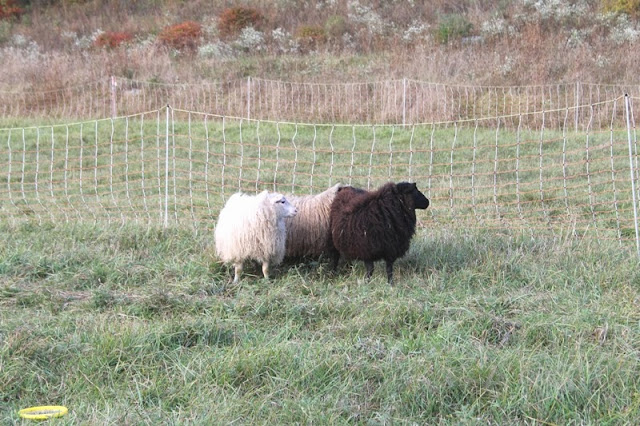At long last, the start of our permanent ewe flock has begun, the arrival three beautiful Icelandic ewe lambs from Whippoorwill Farm in Iron River, WI.
Until now I've only been dreaming of starting our own ewe flock and practicing sheep care with our Amish market lambs.
Last year this entailed trimming hooves, treating hoof rot, trimming hooves, treating diarrhea, trimming hooves, treating pink eye, and trimming hooves.
This season we've had nary a problem with our ram lambs except that they are now getting a bit "rammy" and I have to watch my knees when I'm in their paddock.
{They weren't supposed to get rammy this year... they're all... well... wethers...}
Last winter once the sheep were all gone I spent a fair amount of time researching a variety of sheep breeds, trying to narrow down my "top 10" list to maybe just one or two breeds.
I soon realized most of my favorite breeds had some attributes in common - such as they all tended to be northern European "primitive" breeds, which are basically a breed, usually ancient, that has not been much "improved" by changing the breed to accommodate better meat or wool production. They remain more like they were thousands of years ago. They also all tended to be "landrace" breeds and they all tended to be "short-tailed."
The benefits of these attributes are many - they have survived for thousands of years, usually with minimal management interventions. The ones that were prone to problems and parasites have died off or been culled. They tend to be easy-birthers and great mothers. Their natually short tails mean no tail docking is required, and because of this, ewes will not tend to prolapse (a problem in docked-tail sheep).
In short, they tend to be hardy. And let me tell you, after spending every weekend treating hoof rot and diarrhea last summer in our mixed-breed meat sheep, having something a little more "hands off" was enticing.
Not only that, but we live in the northern Midwest. Winters, although seemingly more often peppered with milder days, still tend to be severe.
We don't have a lot of barn space. The critters that overwinter here must have minimal housing needs. Our alpacas will lounge outside in temps far, far below zero as long as it's not raining. The sheep must be similarly inclined.
So after deciding I really wanted a northern European, landrace short-tailed sheep, I first settled on the Norwegian Spelsau, but upon investigation discovered they've never been imported into the USA.
{rats}
However, there are some other closely related breeds that are currently in the USA.
Such as the Icelandic breed. Not only do the Icelandics meet all of the above attributes, they do so with beautifully, naturally colored fleeces which are dual-coated and grow so fast it is necessary to shear them twice a year.
Their dual coat, consisting of an outer, longer, Tog, is around 27 microns and is fabulous for weaving and rug making and felting.
The inner coat, the Thel, is shorter and finer, around 20 microns, perfect for making things for "next-to-skin" wear.
The beauty of all of this is that my new wool combs will separate these two coats so that I may use them for separate projects or leave them combined. When spun together with a light twist a spinner can make a lofty "lopi" yarn.
{say it with me - Lofty Lopi Lofty Lopi Lofty Lopi...}
So the only question that remained was where to purchase our ewes. After negotiating with a local farm for almost a year and having them back out on us twice, I noticed a posting on Facebook that my first choice farm had decided which ewe lambs they would have available for sale and were taking deposits.
Additionally, their farm was only 40 minutes from Washburn, where we were heading for a weekend of camping with our family. It would be easy to pick the ewes up on our way home that weekend.
I thought we could just put them in the back of our Envoy but Papa Bear poo-poo'd that idea. Something about our camping gear and twin-sized mattress taking up all the room. So we borrowed an alpaca trailer and headed north.
I wish I had some pictures of Whippoorwill Farm. Alas, I completely forgot my Canon Rebel at home that weekend. It was a lovely place, Scandinavian in style, with walking paths throughout the 15 wooded acres which served as laneways to move the sheep into sections of the woods where they did a darn good job of keeping the brush grazed. The woods were dappled with sunshine and young tree trunks and grass, wide open and free of brush.
These sheep browse brush! I no longer have to think about getting goats!
The girls were less than thrilled with being trailered, and even less thrilled about getting off the trailer in some strange field with alpacas and chickens milling nearby. They wanted nothing to do with us, that's for sure. They hung closely to the fence nearest the Amish lambs for the first twenty-four hours.
But I've been working with them, enticing them with apple slices, and now Fönn, the white one, and Börk's daughter, the Moorit (brown one) will come up and look for treats. Eva's daughter, the black one, wants nothing to do with me and wants to know when I am bringing her back to Whippoorwill.
She'll come around.
Cheers -





